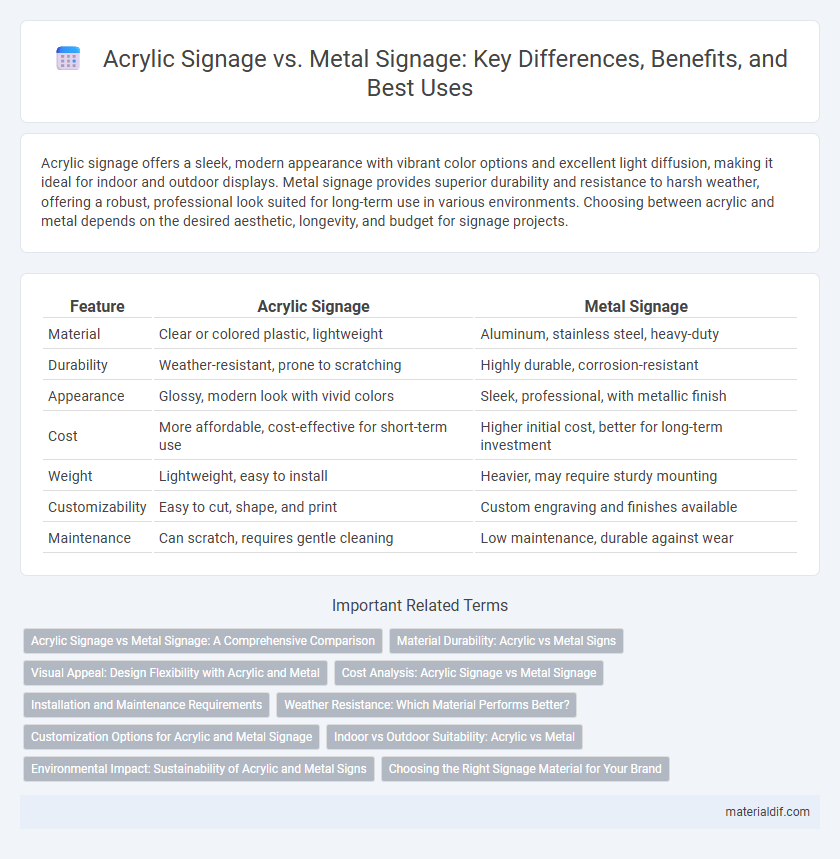Acrylic signage offers a sleek, modern appearance with vibrant color options and excellent light diffusion, making it ideal for indoor and outdoor displays. Metal signage provides superior durability and resistance to harsh weather, offering a robust, professional look suited for long-term use in various environments. Choosing between acrylic and metal depends on the desired aesthetic, longevity, and budget for signage projects.
Table of Comparison
| Feature | Acrylic Signage | Metal Signage |
|---|---|---|
| Material | Clear or colored plastic, lightweight | Aluminum, stainless steel, heavy-duty |
| Durability | Weather-resistant, prone to scratching | Highly durable, corrosion-resistant |
| Appearance | Glossy, modern look with vivid colors | Sleek, professional, with metallic finish |
| Cost | More affordable, cost-effective for short-term use | Higher initial cost, better for long-term investment |
| Weight | Lightweight, easy to install | Heavier, may require sturdy mounting |
| Customizability | Easy to cut, shape, and print | Custom engraving and finishes available |
| Maintenance | Can scratch, requires gentle cleaning | Low maintenance, durable against wear |
Acrylic Signage vs Metal Signage: A Comprehensive Comparison
Acrylic signage offers superior clarity and vibrant color options due to its high transparency and smooth surface, making it ideal for eye-catching displays. It is lightweight and corrosion-resistant, ensuring durability in both indoor and outdoor environments, unlike metal signage which may require additional maintenance to prevent rust. Acrylic's versatility allows for easy customization with laser cutting and engraving, providing more design flexibility compared to the typically heavier and more rigid metal signs.
Material Durability: Acrylic vs Metal Signs
Acrylic signage offers excellent resistance to weathering, UV rays, and impact, making it a durable option for both indoor and outdoor use. Metal signs, typically made from aluminum or steel, provide superior strength and longevity in harsh environments, resisting corrosion and physical damage better than acrylic. Choosing between acrylic and metal signage depends on balancing the need for lightweight flexibility versus maximum durability in demanding conditions.
Visual Appeal: Design Flexibility with Acrylic and Metal
Acrylic signage offers vibrant colors and a glossy finish that enhances visual appeal with smooth edges and customizable shapes, making it ideal for intricate designs and modern aesthetics. Metal signage provides a sleek, durable look with options like brushed aluminum or stainless steel, delivering a sophisticated, industrial feel but with less design flexibility compared to acrylic. The choice between acrylic and metal signage depends on the desired aesthetic impact and the complexity of the design elements to be showcased.
Cost Analysis: Acrylic Signage vs Metal Signage
Acrylic signage generally costs less upfront compared to metal signage due to lower material and fabrication expenses. Metal signage, while more expensive initially, offers greater durability and longer lifespan, potentially reducing replacement and maintenance costs over time. Choosing between acrylic and metal signage depends on budget constraints and long-term investment priorities.
Installation and Maintenance Requirements
Acrylic signage offers lightweight and straightforward installation with options such as adhesive backing and simple mounting hardware, reducing labor time and costs compared to metal signage, which often requires drilling, anchors, and professional handling due to its weight and rigidity. Maintenance for acrylic signs involves regular cleaning with mild soap and water to prevent scratches and UV damage, while metal signage demands periodic checks for rust, oxidation, and repainting to maintain durability and aesthetic appeal. The ease of installation combined with low-maintenance upkeep makes acrylic signage a preferred choice for cost-effective and visually appealing displays in various environments.
Weather Resistance: Which Material Performs Better?
Acrylic signage exhibits superior weather resistance due to its high durability against UV rays, moisture, and temperature fluctuations, maintaining color vibrancy and structural integrity over time. Metal signage, particularly aluminum and stainless steel, offers excellent resilience to harsh weather conditions with corrosion resistance and robust strength, but may require protective coatings to prevent oxidation. Overall, acrylic performs better in retaining aesthetic appeal under prolonged outdoor exposure, while metal excels in structural endurance in extreme climates.
Customization Options for Acrylic and Metal Signage
Acrylic signage offers extensive customization options including vibrant color choices, various thicknesses, and smooth, glossy finishes that enhance visual appeal. Metal signage provides strong durability with customizable features like engraving, embossing, and powder coating for weather resistance and unique textures. Both materials allow tailored designs, but acrylic excels in color versatility while metal stands out in structural customization.
Indoor vs Outdoor Suitability: Acrylic vs Metal
Acrylic signage offers high durability and UV resistance suited for indoor environments where vibrant colors and sleek finishes enhance visibility and branding. Metal signage excels in outdoor applications due to its corrosion resistance and robustness against harsh weather conditions, ensuring long-term durability. Choosing between acrylic and metal depends on exposure factors, with acrylic preferred indoors for aesthetics and metal favored outdoors for resilience.
Environmental Impact: Sustainability of Acrylic and Metal Signs
Acrylic signage is made from non-biodegradable plastic derived from petroleum, contributing to long-term environmental pollution unless recycled properly. Metal signage, typically crafted from aluminum or steel, offers higher recyclability and a longer lifespan, reducing waste and resource consumption over time. Choosing metal signs enhances sustainability by minimizing landfill contributions and supporting circular economy practices through easier material recovery.
Choosing the Right Signage Material for Your Brand
Acrylic signage offers a modern, sleek appearance with vibrant color options and high clarity, making it ideal for brands emphasizing creativity and visual appeal. Metal signage provides superior durability and a premium, industrial look suited for brands aiming to convey strength and longevity. Selecting the right signage material depends on the brand's aesthetic goals, budget, and the environmental conditions where the signage will be displayed.
Acrylic Signage vs Metal Signage Infographic

 materialdif.com
materialdif.com